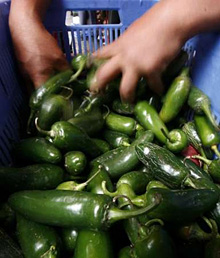
|  |  |  Editorials | Issues | July 2008 Editorials | Issues | July 2008  
Mexico Hot Under the Collar at US Pepper Scare
 Mica Rosenberg - Reuters Mica Rosenberg - Reuters
go to original


| | Jalapeno peppers for sale are displayed at a market in Mexico City July 22, 2008. The U.S. Food and Drug Administration has found a jalapeno pepper contaminated with a strain of salmonella that has sickened more than 1,200 people, officials said on Monday. The pepper, which showed up at a south Texas distribution facility, originated in Mexico but could have been contaminated in a variety of places, the FDA said. (Reuters/Felipe Courzo) | | |
Mexico City - Mexicans are jumping to the defense of the jalapeno pepper, maligned by U.S. health inspectors in a salmonella scare but loved by millions in its ancient home and growing in popularity north of the border.

The U.S. Food and Drug Administration said on Monday it found a jalapeno pepper contaminated with the strain of salmonella that has sickened more than 1,200 people and warned everyone across the United States to stop eating them.

But the warning did little to dampen the appetite for jalapenos in Mexico, where the spicy green pepper is heaped on tacos and sandwiches at almost every street corner.

Jalapenos, named after the eastern Mexican city of Jalapa, were grown before the Spanish conquest in the 1500s and chiles are among the oldest domesticated crops in the Americas.

"Mexico has one of the best cuisines in the world. In the United States they don't understand, they have hamburgers and hot dogs. That's not a tradition, that's just junk," said Pedro Garcia while slathering salsa on to fried tacos at a busy street stall in Mexico City.

Mexico's ancient Aztec royalty favored drinks of chile and chocolate and Mayans tried to cure everything from dysentery, to asthma to vertigo with spicy powders.

"In the United States, they have weak stomachs, everything makes them sick," said Garcia, 46, a school administrator.

The outbreak of the salmonella strain, known as Salmonella Saintpaul, has now made 1,251 people ill and put 229 into hospitals in the United States.

But Mexico's agriculture ministry says that salmonella strain has never been found here and that the Texas packing factory where the pepper was processed might be to blame.

NEW FASHION

Despite the salmonella outbreak, jalapenos have become increasingly popular in the United States, both in Mexican restaurants and on supermarket shelves.

"It's the new fashion," said Jose Manuel Gochicoa who heads the chile growers' association in Mexico, the world's largest producer of fresh chiles.

Exports, most of them to the United States, have risen between 10 and 15 percent every year over the last decade and now over 100,000 hectares (247,000 acres) of peppers are grown in Mexico, 80 percent of them jalapenos.

Dozens of varieties of chiles, some which provoke sweating and crying, have become a cooking trend in the United States. Food writer and spice expert Dave DeWitt describes the fad as "culinary bungee jumping."

"Very rarely do you ever hear someone say, 'I used to eat hot and spicy food but now I'm back to bland,"' said DeWitt, the author of over 30 books on chiles like "The Spicy Food Lover's Bible" and "The Chile Pepper Encyclopedia."

Inspectors are holding up truck loads of the some 100 tons of peppers crossing into the United States from Mexico every day, raising the risk of produce being left to rot before it reaches stores, Gochicoa said.

"By creating this bottleneck at the border, people are just going to stop exporting," he said.

Health inspectors have had trouble identifying the origin of the salmonella bacteria and first blamed tomatoes grown in south Florida or Mexico.

(Editing by Kieran Murray) |

 |
|  |



